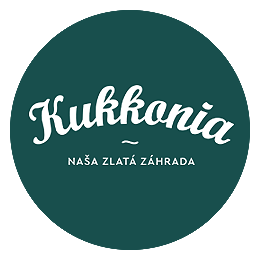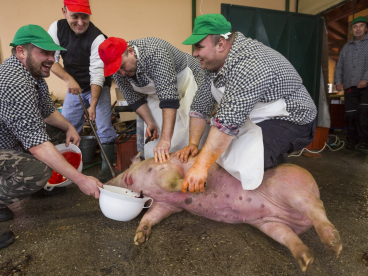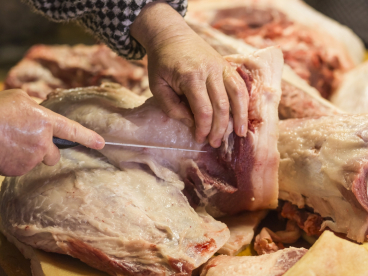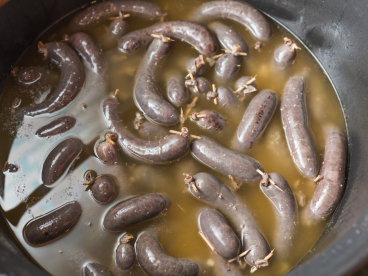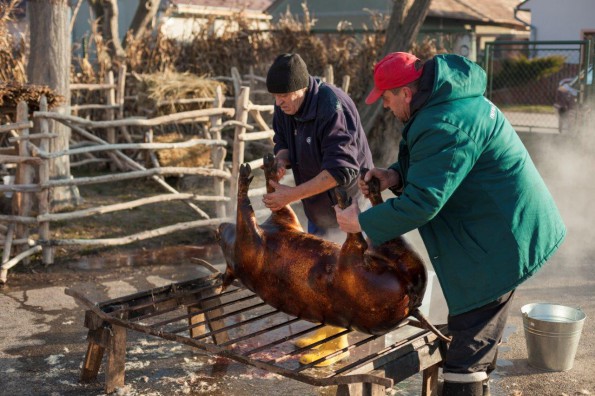
The pig screams, he knows it is the end for him. My sister and I turn away, while a tear falls from the corner of our eyes. We plead with the adults not to harm the animal. The pig- sticker laughs at us. “This will make delicious meat.”
Finally, I give way, but 25 years later I still cover my eyes, when in the early morning I hear the last screams of the pigs. But now it is not just one, but 12 pig-stickers, who are laughing at me. “Yes, and hold your nose,” they joke with me. Finally, I pull myself together and think that I cannot be this squeamish, after all I am a country girl. In addition, after a long time I am glad that I can attend a genuine traditional pig killing.
The animal goes quiet, but the real activity begins. The pálinka is poured out, while the pig’s blood is poured into a red basin. “Will you have a taste?” I shake my head; I am afraid they will laugh at me again. It turns out that many people like the fresh blood. And as we stand around the pig, it occurs to me, how much pig killing has changed today. I have seen more than once that the pig absconds and runs into the courtyard, spilling blood. When I tell them the old stories, the pig-stickers only nod, yes indeed, pig killing is much more humane than in those days. Then one of them add, “Paralyzing the pig with an electric current makes our work easier. And the animal does not suffer as much.” I calm down a bit, but this does not last long. The next pig is brought up, as they are going to kill six pigs. As I begin to back away again, one of the pig-stickers remembers the choreography. “You must not have had any pálinka.” We laugh and I nod. How true! Every pig killing in Csallóköz must begin with a good pálinka (in my case, should). “We begin with a half. Then comes the other half, to prevent us from getting dizzy and so both feet should get a little courage. Then so as to make sure that there should be the same in both, we drink a third. After that, we can set to work,” they say, then they put a shot glass into my hands. All right, does it burn? All right then. Next comes the scorching.”
In the old days, the pig was scorched with straw, today that has completely changed. The scorching took too long and the pig’s skin did not taste too good. But there was not any other solution. “It’s possible we would be in trouble if there weren’t bottles of gas,” comments one of the pig-stickers. They agree that at least the pig does not have a smoky taste. In addition, it does not take so long, an hour in all, then the pig can be washed and scraped. While they scrape the pig, I sneak into the kitchen to watch the women.
I can hear from afar what a good mood the women are in. I realise that when they are by themselves, they discuss the important women’s things. When I turn on my dictaphone, they immediately go silent. They cannot divulge their secrets in front of the public, after all. I convince them that I will omit those. As I bustle about, suddenly, the world goes dark. That is it, it is over, I go blind. My eyes narrow and I know, who or rather, what is at fault. I smell onions. Well, of course. The blood is being fried. Mush, blood sausage, cabbage and fried meat are put on the table. The women wash the dishes, they wash the guts, and they prepare the good food from good contents. They have been bustling about in the kitchen since 6:30 in the morning. They peel the onions, cook the rice and prepare the other ingredients. “How can it be,” I ask, “that onions do not make your eyes smart?” They retort, “Oh, yes, my dear, of course they smart. They smart. Only we have got used to it.” They smile, and why, there are a few pálinka glasses in the commode. I can see out of one eye how skilfully their hands work. We sample, we laugh, then we reminisce about the good old days.
“When they kill a pig, they stick a knife into it, they have to put the basin under it to catch the blood. I had to do that too. Otherwise, there is no fried blood, no blood sausage, nor kása (mush). Not everyone can bear this. Now too, as I fried the blood, I felt a little sick,” one of them confesses. I listen in relief. (At least I was not sick at the sight) Though I have to confess that I tasted fried blood for the first time. They say, it is about time, there is nothing better. The secret is that a bed of onions should be fried, then the blood is poured on it, a few caraway seeds are added, some salt and it is ready.
It’s simply scrumptious. Not like the other women’s task, the washing of the guts. In the old days, the girls washed the guts, which were often wormy, in the stream or river in the early morning. That was about ten years ago, since these days we can buy the membrane of the blood sausage and the sausage in the shop. Of course, there are places where the “guts are still washed.”
“I’ll tell you a secret. The most important element in pig killing is the woman. Only do not tell her. Oh yes, and the pig.” Joci whispers to me, the chief pig-sticker when I come back from the kitchen to join the butchers. Music, meanwhile the pig-stickers’ hands work assiduously. They hang the pig on a hook and pull out its guts, which end up in a cauldron. The meat processing is begun and the time for the questions has come. “What do you make of each part, where do you put them?” I ask and I do not have to wait long for a jokey answer. “If we can pick it apart, we cut it up, if not, it goes into the meatloaf. Then they put them all in a row, blood sausage from the blood, fried blood becomes abált kása (or beggar’s kása) or mush. The shoulder is juicier, it will become stew, the pork chop is usually fried, the chuck is good for roasting. And as they list each part, they add that people do not eat much pork these days. “We have become such a fastidious nation, we only eat chicken breast.”
While they take apart the pig, they sort the parts, this one here, that one there, they hand them to the women in the kitchen, who will prepare the midday meal. Even the pig-sticker gets hungry if he works hard all day. Thus, dinner is served at noon, they eat and drink, clean up, then continue the work. Meanwhile the cauldron is bubbling, the meat is cooking and the abált bacon (cooked in water) and the good pig-killing feast’s cabbage. “In the old days, the pig-killing took two days. We did not have good equipment, many of the cauldrons, even the blood sausage filler were the old heavy ones that pressed on your belly. The whole procedure was more difficult and slower. We filled all the guts, even the bladder. We pumped them up and stood until we filled them up. After roasting we poured the fat onto the roast in the pot. It is how we conserved it. (Today this is fashionably called confit). We also can it. Interesting that these days in many places the pig is slaughtered, they process its meat but leave the guts. And yet so many delicious things can be made from them,” they say all together. Then I ask, what other secrets can they tell me about the pig-killing of Csallóköz. They laugh, well, if they reveal them, I will end up like the pig.
After the joking, Joci answers. “The secret lies in the seasoning of the food, the meat. We like Hungarian seasoning, paprika, salt, pepper, garlic and caraway seeds. We still try to hand on the traditional flavours. So that our blood sausage, the sausage and the kidney and brains, cooked in water or beggar’s mush, will be truly of Csallóköz. And if we are still talking about secrets, we must not forget something very important cracklings. The pig-stickers point at a bearded fellow, namely Gyula bácsi, to show that they had a separate crackling master. He has the most responsible job in the entire pig-sticking process. “If someone ruins the crackling, he ruins the entire pig-sticking. Indeed, he ruins the mood,” he assures me. Then they add. “True, you have to be careful with preparing the meat too, since a lot of meat can become little meat, not to mention that it can be made into meatloaf.”
I ask Gyula bácsi for the secret of good crackling. He immediately initiates me, ”We cut up the bacon/lard, melt it and fry it in a cauldron in milk and salt. Of course, the proportions are important. That is what the quantity of fat depends on.”
Meanwhile, I see from the corner of my eye that the cooked meat is laid out on the long table. As the steam rises, everybody goes to the table and they bring the salt. ”This is the best,” they point. ”The meat of the head and the glands. This round thing here. Do you see? Come on, have a taste. We call it white liver.” And as I taste it, I agree with them. Surely there is nothing tastier.
Meanwhile the sausage, headcheese, the blood sausage and liverwurst are being prepared. Where to now? The mood is getting better and better and I am thinking how tiring this pig-killing is. No wonder it used to take many days. The fat had to be rendered. The bacon, ham, and sausage had to be got ready for smoking.
That is why I try to find out how everybody stands up to the hard work. Comes the answer. “Now? Ah, no. At such times we are not tired. At the end. That is tiring. Around midnight, people begin to break.” They laugh and I laugh with them, while I glance at my watch. Where is midnight from now? Meanwhile, Gyula bácsi takes me to the crackling, to have a taste. And no mistake, it really is divine, he is an expert. I watch how the others are stirring the cabbage, cutting up the meat, filling the blood sausage, while they talk and joke. I realise that this is the most important part of the pig-killing. And it was always thus. It brings people together. Of course, the villagers produced their daily victuals for themselves. Not to mention that they can use every part of the pig. Formerly, pigs were killed for wedding feasts, new year’s, festivals, beginning with Saint Andrew’s (November 30), but only in cold weather to prevent the meat from spoiling. The year’s end pig-killing was very useful, since it was for the entire year. Today, mostly pig-killing festivals remained, but during winter there is real traditional pig-killing here and there.
It is so good to see how joyfully the women and the pig-stickers do their work. They cut the meat, pinch it, salt it and chew the meat. They stir the cauldron, they cook the meat, fill the blood sausage and oh boy! The real pig-killing festival is ahead of us. The dancing, entertainment, eating, and drinking. I have so many tastes in my mouth and so many delicious fragrances in my nose, that I am totally full. I vow to set to work the next time and try out the women’s and the men’s jobs. I wash the guts and cut the meat. Or if nothing else, make meatloaf.


